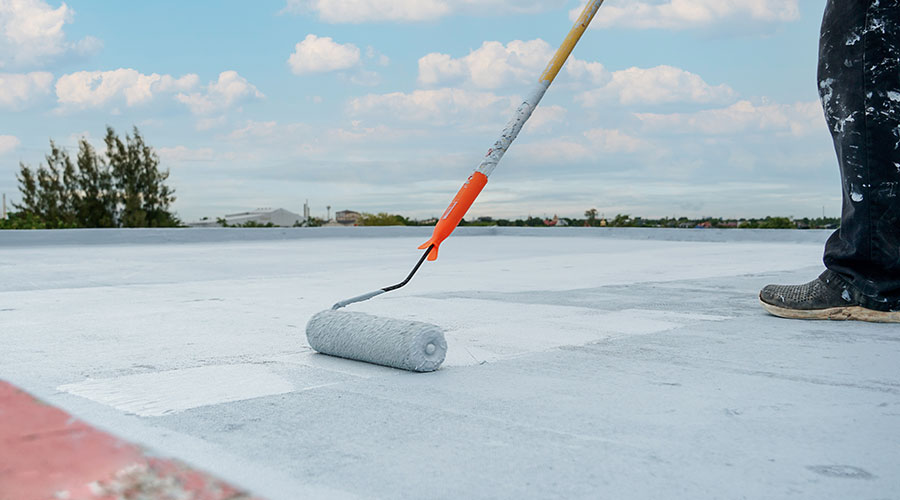Raising the Roof
Heightened interest in the roofing-energy connection prompts a closer look at the role of roof coatings
Roofing systems and energy management generally haven’t been mentioned in the same sentence in maintenance departments. In fact, aside from discussions of locating rooftop HVAC units, the managers responsible for the two areas probably crossed paths only rarely. This situation is changing, however, and a growing number of facilities are rethinking the importance of roofing management in energy savings. Among the roofing products receiving closer scrutiny for their potential to help curtail buildings’ energy use are roof coatings.
Managers traditionally have specified coatings to repair leaks and protect roofing system components from the elements. But newer products, including a growing selection of white and reflective coatings, also offer managers enhanced ability to keep rooftops cooler and, therefore, reduce a building’s cooling load.
Pushing Energy Savings
Several factors are driving this shift. Among these is the recent update of California’s Title 24 design standard, which went into effect in October 2005. The update’s goal is to tighten the requirements on new commercial components, including windows and HVAC systems, but it also mandates cool roofs for new commercial buildings.
Also, the Energy Policy Act of 2005 provides tax deductions for owners of commercial buildings that exceed the requirements of ASHRAE Standard 90.1-2001, Energy Standard for Buildings Except Low-Rise Residential Buildings. To qualify for the deductions, building improvements must be installed as part of interior lighting, HVAC, or hot-water systems, or the building envelope, including roofs.
These standard-setting actions parallel conversations that already were taking place within many departments and organizations.
“Many architects, while trying to satisfy the energy quota requirements of ASHRAE 90.1, are doing so in the mechanical area, rather then looking at envelope,” says Richard Robben, physical plant director with the University of Michigan. “We recently decided to rethink our energy conservation section of our design standards to perhaps bring more attention to this area.” Robben’s department is hardly alone in rethinking its energy management program to more closely incorporate roofs and coatings.
“The type of system that we specify definitely has changed as a result of energy costs,” says Peter van der Have, director of plant operations with the University of Utah. “So, insulation, reflectivity, etc. all play a larger role now than they ever have.” There are limits to the shift, however.
“We have not gone specifically after projects that would replace roofing systems only, and for the sole purpose of conserving energy,” van der Have says. “Where it has made sense to do so as part of a larger, more broadly scoped project, appropriate attention was paid to the type of roofing system installed.”
Managers also understand that energy savings is only one consideration in selecting any product, albeit an important one. Their first priority is selecting roof coatings that perform well over the long term.
“Products that promote improved performance or ease of installation are more prevalent than those claiming their product will result in additional energy savings,” says Travis Luzney, manager of maintenance and repair with Milwaukee Public Schools.
Many managers no doubt are answering more questions these days from facility executives about roofing issues. But those who have specified light-colored and reflective coatings over the years are well aware of the cooling benefits these products can provide.
“Back when we first started using roof coatings, we noticed a marked difference in temperatures in the attic spaces,” says Clark Neilson, coordinator of general repairs for the Clark County (Nev.) School District, which includes the rapidly expanding city of Las Vegas. “The purpose of the coating was to seal the roof from leaks and to help prolong the life of the roofing materials. The reflective properties of the product were considered but not to any great extent. Some studies were done, and that’s when its energy-saving potential was realized.”
Still, Neilson believes the biggest benefits come from a comprehensive roofing maintenance program that includes coating applications one as just one component.
Says Neilson, “We’ve found that regular preventive maintenance, inspections, roof cleaning, sealing any defects or damage, and coating a roof with a white reflective coating not only can protect the existing roof materials, but also extend the life of a roof well beyond its normal expectancy.”
Application and Performance
Because of the rising interest in the benefits roof coatings can bring to organizations’ bottom lines, managers are paying greater attention to the products they specify. And they are finding a selection of coatings that is growing in response to market demands for performance and energy savings.
“Our preventive maintenance program provides for a silver coating application every five years to primarily protect the roof and increase its overall life,” Luzney says. “While energy savings isn’t our primary reason to silver coat, we indirectly receive the benefits of minimized cooling loads on those buildings that are occupied in the summer and that have an AC system.” Some newer types of coatings have created unforeseen challenges in the field that managers will need to consider well before application. For example, the location of coated roofs relative to nearby buildings might affect the choice of coatings.
“Most of the coatings that we apply after the fact, on existing roofs, are light-colored,” van der Have says. “We try to avoid reflective coatings since occupants in taller, neighboring buildings complain about the unbearable brightness.” Light-colored coatings also can present managers with challenges when it comes to appearance.
“The white coatings we tried did not perform as well as expected,” Luzney says. “They turned a dull gray and appeared to lose their reflective properties sooner than the aluminum coating.”
Manufacturers’ Role
To avoid such problems, managers can consult with the coatings manufacturers during specification and discuss the recommended application, inspection and cleaning procedures that can help coatings retain their color over the long-term. Manufacturers are fully aware of the growing interest in their products and will be more than happy to talk.
“It is refreshing to see the sustainability and energy savings attributes of reflective roof coatings re-discovered by maintenance professionals,” says Chris Salazar, president of the Roof Coatings Manufacturers Association and vice president of sales and marketing with Karnak Corp. “Coatings manufacturers have long touted these benefits, which have been validated by government, industry and private studies. Coatings are an economical way to prolong the life of a roof, while enhancing the overall energy efficiency of the building. Other benefits, such as tax advantages, LEED points and energy savings simply add value.”
Conversations with manufacturers also can help managers develop a program that pays dividends more quickly.
“We are now in a systematic schedule of coating or recoating every building in the district,” Neilson says. “A facility or entire school that has an increasing history of leaks is being addressed first, and the end result is not only a complete elimination of leaks but a noticeable decrease in energy costs connected with heating and cooling.
“The performance of the roof coatings has been impressive. It has exceeded the expectations of everyone connected with our roofing efforts.” The shifting role of roofs and coatings in discussions of energy management no doubt are helping organizations generate additional savings. But the shift also is affecting the role that maintenance departments and managers play in broader facility management issues.
“The time of slapping a bucket of tar on a trouble spot has passed,” van der Have says. “It is my impression that, finally, the design industry is beginning to acknowledge that the roofing system is one of the most important system on a building. So it’s our job as maintenance professionals to help identify the type of roofing that has the best performance record in our particular climate.
“We need to be able to demonstrate to the designers why certain systems work on a life-time cost basis and why others don't. With so much more high-tech stuff going into our buildings, preventing any kind of roof leak is more critical than ever.”
Spotlight: RCMA
The Roof Coatings Manufacturers Association (RCMA) is the national trade association representing manufacturers of cold-applied protective roof coatings and cements, as well as suppliers of products, equipment and services to the industry.
Since its founding in 1982, the association has tripled its membership to almost 50 member manufacturing and supplier member firms and affiliate and contributory members. Association benefits and activities include:
-
a vehicle for input into federal and state regulations and legislation
-
government affairs and regulatory issue updates
-
technical and regulatory compliance educational seminars
-
a new membership option, the white coatings division, to serve producers and suppliers of acrylic or elastomeric coatings.
RCMA also recently issued an updated and revised version of its RCMA Volatile Organic Compound (VOC) Guide. The guide provides information on EPA’s architectural coatings rule, specifics for ozone transport commission (OTC) states, and applicable standards and regulations.
For more information, visit RCMA at www.roofcoatings.org or call (202) 207-0919.
|
Related Topics:











